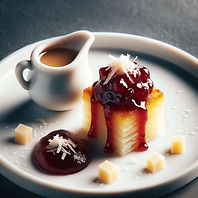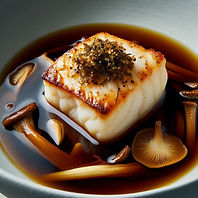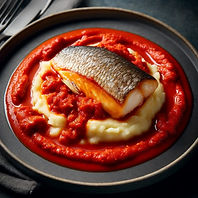Top Chef ™: Wisconsin
Season:
Week:
Personal Growth

Kristen Kish: "Final elimination challenge here in Wisconsin? We want you to take a look back on your time here and give us a dish that shows us how you've grown as a chef. Was there a breakthrough or an aha moment, or is there a dish that you know you'd crush now that you didn't early on? We've seen you grow so much these last many weeks. We want to see that on the plate."
"Obviously, this is the dish that's going to really determine who's moving on to the finals. Take all these experiences, what you've learned as a chef, and get it onto that plate. Put it all out there."
"So today, you'll each get $150 to shop at a specialty store. You'll then have $200 to shop at Whole Foods Market. Tomorrow, you'll have 3 hours to prep and cook at Paul's restaurant, Harbor House. You'll be serving a table of local chefs, some that you might recognize."

As a family-run site, we pour our hearts into recording and transcribing cooking shows, developing tested recipes, and sharing culinary insights—all without bombarding you with ads.
Your low-cost subscription would help us cover ingredient costs and confirm that our passion project matters to you.
Please join our cooking community today.
Dishes prepared in
Top Chef ™: Wisconsin

Savannah: "I made potato pave, chicken sauce reduction, and a jam made of burnt onion and cherry. I think that potatoes have everything that they naturally need to make a pave. We just have to add heat and pressure, and so heat and pressure of this competition, I realized I naturally had everything I needed. I just needed these experiences to bring it out."
Judges: "Well said."
Kristen Kish: "That's probably one of the best deliveries and explanations of edition I've ever heard."
Judge: "She's very articulate, very thoughtful, great storyteller."
Judge: "And to make a pave in that amount of time, that's hard."
Judge: "And it's a nice pave. It does take a lot of guts to use the pave as the star of the plate."
Judge: "And I just adored the sauce, the cherries, and the caramelization of the onions. I just thought it was a lovely pairing, and I feel like storytelling is the thing that separates good food from exceptional food. I love a potato pave, and I love it even more now that Savannah told us why she made a potato pave."
"It shows growth. I mean, that's it."
"No question."

Manny: "So I have a snapper, a la Veracruzana with creamed potatoes and saltines. Just because that's a way that I will eat it back home. I wanted to reach back to my roots, which is when I have felt the most comfortable in this competition. I want to make sure I keep honoring the cuisine of my people."
Judges: "Great. Thank you, Manny."
Guest Judge: "Delicious. You know, the fish is beautifully cooked. I like the little tartness of the tomato, the creaminess of the potato. I think it's good."
Tom Colicchio (shaking his head in ardent disagreement): "Not even close. The fish is raw."
Another judge: "Mine's not cooked either."
Yet another judgeL "Really? Oh, no. Mine's, like just right."
"Yours is beautiful. Mine is beautiful. Like, literally spot on."
"Mine's perfect."
"I think when you do a dish that's this seemingly simple, all of the details matter."
"I'm happy that he showed us something that was personal to him. There is a piece of me that wonders, did he fit the dish to the story or the story to the dish? I think Manny's dish has nothing to do with the journey in Wisconsin at all."
Tom Colicchio: "It's a good dish. Potatoes are nice and creamy. It's just, that's a pretty major flaw."

Laura: "This is Lamb Manti, an eastern Mediterranean pasta. I made a barbacoa, blended that with a little bit of guajillo and some tomatoes. Usually on my dishes, I was putting too many components that were not making too much sense. Top Chef actually taught me how to do it in a more focused way."
Judges, bheind the scenes ...
"The dumpling pasta is pure love."
"Yeah."
"The pasta and the lamb inside is a delicious bite."
"I appreciate the guajillo in there. I like the balance that it had."
"Her dish is focused. Her plating is beautiful."
"It's really hard to overlook the technique behind her dish."
"It's good. It's really delicious."

Danny: "I made a soba cha mushroom broth with mushroom puree, cod, and a little furikake on top."
Gail Simmons: "So what's the inspiration behind this?"
Danny: "There's kind of two points. One, just to redeem myself a little bit for the terrible tea that I served you at restaurant wars. And then subtle dishes typically get lost here in the top chef kitchen. So I wanted to do what I interpret as a subtle dish with a lot of nuanced flavors."
(Judges, eating, look at each other.)
Judge: "So you think this is subtle?"
Danny: "I think it has some restraint to it. Yes."
Judges (behind the scenes) ...
"It's not subtle. Nothing subtle."
"It's a good dish, but it's clearly not subtle."
"I love the Japanese aspect of it. I love the way that the furikake brings the ocean back into the fish, but I'm not necessarily reading the tea aspect of the dish."
"You know, if tea's gonna be your main point on this storytelling, why isn't it just swimming in this, like, gorgeous bath of tea? I mostly tasted the mushroom."
"The fish was just sort of lost."
"The fish is buried in a lot of big flavor. Yeah, that said, it's a good miss."

Dan: "My dish here is smoked walleye, lemongrass, turmeric, brown butter emulsion, potato dumplings, and then some herbs. Basically, my growth here is I was learning to just cook from a sense of place, and that's the backbone of this dish is all about Wisconsin. And then from there, I refuse to put myself in a box. Therefore, I love the idea of global influence with stuff like turmeric. I just went for it."
Judges, behind the scenes ...
"Absolute maximalist."
"Yes."
"It's a lot of everything, but many of these elements work."
"I love smoke. But I'm finding that all I'm eating is smoke."
"I like the contrast in that smoky flavor to the richness and depth of the broth. But it needed something fresh. It was really heavy for me."
"It feels to me like the story and the dish from Dan were a little bit muddled."
"I'm not getting turmeric, I'm not getting lemongrass. But the flavor that's there is good. There's just a lot going on. It's really suffering from an identity crisis. "
Culinary Challenges inspired by
Top Chef ™: Wisconsin

Achieving the judge-praised visible layers in scallion pancakes requires proper technique and understanding of lamination principles. Start with properly hydrated dough that's pliable but not sticky - boiling water creates the right texture while oil adds workability. The key is in the rolling and folding sequence: brush each rolled circle generously with sesame oil and sprinkle evenly with chopped scallions before rolling into a tight log. Coiling the log into a spiral and then re-rolling creates the laminated structure that produces distinct, visible layers when cooked. Rest periods are crucial - they allow gluten to relax for easier rolling and help oil distribute evenly. When cooking, medium heat allows layers to puff slightly while developing golden color. The final result should show clear stratification that impressed the Top Chef judges.

Creating 'reserved seasoning' that doesn't overwhelm requires understanding how different spices contribute heat and flavor. Ground Szechuan peppercorns provide unique numbing sensation rather than burning heat - use sparingly as their effect builds over time. Cumin should be the dominant flavor, providing earthiness without excessive heat. Red chili flakes add brightness but can quickly overpower - start with less than you think you need. The key is building flavor in layers: bloom spices in hot oil to release aromatics, taste as you go, and remember that heat intensifies as dish sits. Shuai's success came from restraint - allowing each spice to contribute without any single element dominating. This responsible approach lets diners appreciate complexity while ensuring broad appeal.

Tiger salad's 'super herbaceous' quality comes from using multiple fresh herbs in proper proportions while maintaining textural contrast. Combine equal parts cilantro, mint, and Thai basil for complexity - each contributes unique aromatics that create layered freshness. Julienne vegetables (cucumber, carrot) uniformly for professional appearance and consistent bite. The dressing must be bright and acidic to cut through rich lamb and cheese - rice vinegar provides clean acidity while sesame oil adds richness. Sugar balances acid, and chili oil provides subtle heat that complements rather than competes. Dress salad just before serving to maintain crispness. Crushed peanuts add textural interest and nutty flavor that ties Asian elements together. This fresh component provides the brightness judges praised while cleansing the palate between rich bites.

Successful bread pudding requires proper bread selection and custard absorption technique. Day-old brioche or challah provides ideal texture - fresh bread becomes soggy while too-stale bread won't absorb properly. Cut bread into uniform pieces for even soaking.
The custard ratio should be rich enough to flavor thoroughly but not so thin it creates soggy results. Allow 30-45 minutes soaking time, pressing gently to submerge all pieces. Properly soaked bread should absorb custard completely with no pooling liquid visible.
The goal is creamy custard that binds bread pieces while maintaining some texture contrast. This technique ensures Michelle's supper club comfort food appeal.

Mbongo (or Mbongo Tchobi) is Cameroon's distinctive spicy black stew, typically eaten by the Bassa people of Cameroon but gaining popularity nationwide.
This one-pot spicy black stew is made with aromatic traditional spices and fresh herbs simmered with fish.
The signature element is the mbongo spice itself: alligator pepper that's been burnt till it's black.
Key cooking tips include toasting the seeds of ndjansang, alligator pepper spice, and other aromatics in a frying pan first for deeper flavor. Blend tomatoes, onions, garlic, ginger, leeks, celery, African nutmeg, njangsa, and mbongo spice into a paste, then simmer with fish for 10+ minutes until cooked through, adding water as needed to prevent burning.
Serve with boiled plantains, rice, or yams for an authentic Cameroonian experience.

Cassareep is a thick black liquid made from cassava root, often with additional spices, essential to Caribbean cuisine, particularly Guyanese cooking. The juice is boiled down until it caramelizes, forming a syrup, often with cinnamon, a bit of brown sugar, cloves and honey.
While most famous in pepperpot stew, cassareep's complex molasses-like sweetness with earthy undertones makes it surprisingly versatile. Beyond traditional savory applications, it works beautifully as a flavoring agent in desserts. The syrup's natural preservative qualities and concentrated flavor make it ideal for ice cream—use sparingly, about 1-2 tablespoons per quart, as its intensity can overwhelm.
In ice cream, cassareep creates a sophisticated flavor reminiscent of burnt sugar or dark caramel, with subtle spice notes. It pairs exceptionally well with coconut, vanilla, or rum-based ice creams. This dark, bittersweet juice, when boiled down with cinnamon and honey, adds depth to both sweet and savory preparations.
Always purchase commercially prepared cassareep rather than attempting homemade versions, as proper processing neutralizes the cassava's natural toxins.

Ambrosia salad, the quintessential Southern side dish, is easy and quick! It usually includes mandarin oranges, pineapple, coconut, marshmallows, and "Cool Whip". This nostalgic "food of the gods" transforms simple ingredients into creamy, tropical heaven.
The key to perfect ambrosia lies in proper preparation and timing. Always drain canned fruits thoroughly, since excess liquid will thin your salad and dilute flavors. Fold the sour cream and whipped topping together in a large bowl first to create a smooth base, then add the pineapple, oranges, cherries, marshmallows, coconut, grapes and pecans. Continue to fold until everything is thoroughly mixed.
Cover bowl with plastic wrap and refrigerate until flavors blend, This resting time allows marshmallows to soften slightly and flavors to meld beautifully.
For best results, use mini marshmallows rather than large ones, and add delicate fruits like grapes last to prevent crushing. Some families swear by the "5-cup" version using equal parts of each ingredient.

Panipuri, India's beloved street snack, consists of crispy hollow puris filled with a spiced mixture and served with a tangy flavored broth.
Making perfect puris requires technique: combine suji (semolina) and oil, rubbing with fingers until it resembles breadcrumbs, then add water gradually and knead into a tight dough. Roll very thin—thickness determines whether they'll puff properly during frying.
The crucial step is frying: fry puris on medium heat (not high heat) until they turn crispy. They should balloon into hollow spheres. Test oil temperature with a small piece—if it rises immediately, it's ready.
For assembly, gently crack a small hole in each puri, stuff, and fill with the signature tangy water or broth just before eating. The magic lies in consuming them immediately—one bite releases the explosion of flavors that makes panipuri irresistible.

Anolini are very specific to the region around Parma and involve an even more complicated procedure than tortellini. These delicate round pasta parcels are traditionally served in rich capon broth during holidays.
The filling is distinctly complex: lean beef is simmered with carrots, celery, and onion for a full day, then finely minced and mixed with breadcrumbs, parmesan cheese, and stewed beef juices. The breadcrumbs require specific preparation—fresh bread cut in cubes the day before, dried in the oven, then processed "not too fine, not too big, but in the middle".
For shaping, gently press the anolini stamp across your pasta sheet to create light markings before adding filling. This guides placement and ensures even distribution. Just before sealing, use a spray bottle to lightly mist the edges for better adhesion.
Cook anolini in salted water for 3 minutes rather than directly in broth to prevent cloudiness then serve immediately in steaming brodo.

Tomato dashi represents a brilliant fusion of Japanese umami principles with Western ingredients, creating an intensely flavorful broth that transforms ordinary dishes. This innovative stock combines the depth of traditional dashi with tomatoes' natural glutamates.
To make tomato dashi, start with quality canned San Marzano tomatoes or peak-season fresh ones. The authentic version involves stewing raw shiitake mushrooms and kombu with tomatoes rich in umami. Begin by making a basic kombu dashi. Soak dried kelp in cold water for 30 minutes, then gently heat without boiling. Add crushed tomatoes and simmer for 45 minutes to develop complexity.
For a refined version, puree the mixture with an immersion blender until smooth. Strain through fine mesh for crystal-clear broth, or leave chunky for rustic applications.
This versatile base elevates ramen, risotto, and braised dishes. It works beautifully in Western applications like minestrone and curry Home, bridging culinary traditions. The result delivers profound umami that's both familiar and surprisingly sophisticated.

Pizzelle, Italy's delicate waffle-thin cookies, offer incredible versatility beyond simple snacking. These crisp, lightly sweet discs become edible art in creative hands.
The key to perfect pizzelle lies in your iron's temperature—too hot creates burnt edges, too cool produces chewy results. Look for a light golden color and steam that stops emerging from the iron. Work quickly while they're warm and pliable.
For cannoli shells, immediately wrap warm pizzelle around a dowel or cannoli form. They crisp up within seconds, creating elegant tubes for ricotta filling. Crushed pizzelle make exceptional crusts for cheesecakes or ice cream bases—their anise flavor adds sophisticated depth.
Layer whole pizzelle with mascarpone and berries for an impressive tiramisu-style dessert. They also excel as ice cream sandwich "cookies" or can be molded into bowls while warm for serving gelato.
Store finished pizzelle in airtight containers with parchment between layers. If they soften, crisp them briefly in a 300°F oven. Their neutral sweetness complements both fruit and chocolate perfectly.

Redfish (red drum) is a Gulf Coast treasure prized for its firm, mild flesh and versatility in the kitchen. Redfish was made very popular by chef Paul Prudhomme and his blackening method, but this adaptable fish excels in many preparations.
The key to perfect redfish is respecting its delicate texture. Leave the skin on for tender meat. The flesh won't dry out and will stay moist. When pan-searing, cooking on the stove lets you control heat and timing, achieving a golden-brown crust while keeping the fish moist and tender inside.
For blackening, use a screaming-hot cast-iron skillet and don't move the fish once it hits the pan. Let it develop that signature crust. The fish is done when it flakes easily and reaches 145°F internal temperature.
Redfish's mild flavor pairs beautifully with bold seasonings like Cajun spices, citrus, or herb butter. Whether blackened, baked with lemon, or simply pan-seared, avoid overcooking. This fish goes from perfect to dry quickly.
Best dishes in this challenge
Top Chef ™: Wisconsin
Worst dishes in this week of
Top Chef ™: Wisconsin
Featured Recipes from Top Chef ™























